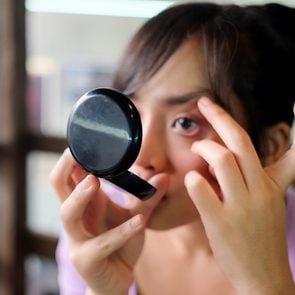This Young Woman Was Haunted By the Sounds of Elevator Music and Seagulls Squawking—But Nothing Was There

The auditory hallucinations were only the beginning of her terrifying medical mystery.
One sunny day in June 2020, Lauren Wells and a few friends set out for a weekend of fun on the Lake Erie Islands. She had reason to celebrate. At just 25, she’d been hired as the head administrator of a nursing home in Sandusky, Ohio.
But the trip wasn’t as carefree as Wells had hoped. On the first night, she felt a shooting pain in her left side, and she had to urinate much more often than usual. She chalked it up to cramps and the fact that she was drinking, and tried to enjoy the rest of her time away.
The following week, however, the pain was still present. Plus, her hands started to feel funny, as if there were a slimy film on them. A friend guessed Wells might be stressed from the new work. “But that didn’t feel right to me,” she says. “I was loving my job.”
The First Auditory Hallucinations
A few days later, as Wells was trying to fall asleep, she started hearing music—a faint elevator-type song that seemed to be coming from outside or the apartment above hers. She looked out the window, expecting to find a street party, but there was nothing. So she went back to bed and tuned it out. But the next night, the music returned. And again the evening after that. Eventually, she wandered the streets, searching for the source. “I was so intent on finding this music,” she says. But she couldn’t pinpoint where it was coming from.
Then things got weirder. The same music seemed to be playing at work and at the bar, and she heard it in the hum of an air conditioner. A friend of a friend, who is an audiologist, explained that people sometimes hear melodies in mundane noises. That comforted her—but not for long.
About a week after the music began, Wells was in Perrysburg, a small Ohio town where she used to live, visiting friends and clearing out her old apartment. One night, she heard seagulls squawking outside her bedroom window. “There are no seagulls in Perrysburg,” she says. It didn’t seem like the audiologist’s theory could explain sudden squawking in an otherwise silent bedroom. “Up until then, I didn’t think I was hearing things that weren’t there,” she says. “But when I heard seagulls, I was like, ‘Something is wrong with me.’”
Unable to sleep, Wells drove herself to the emergency room. The nurses ran some routine tests, but everything came back normal, so they sent her home with lorazepam, an anti-anxiety medication, and a referral to a psychiatrist.
Later that week in Sandusky, during a work meeting that Wells was supposed to be leading, she suddenly spaced out, confused and unable to speak. Concerned, her colleagues—a room full of nurses—called an ambulance. By the time she arrived at the local hospital, she was back to herself. The episode had made her doubly sure something was up, so she called her father, Brad, and voluntarily admitted herself into the psych ward, where doctors put her on a number of medications, including lithium and ziprasidone, an antipsychotic used to treat schizophrenia.
When Brad arrived at the hospital, his daughter didn’t seem like herself. (Wells remembers very little from this point on.) One moment she was acting aggressively with her nurses; the next, she was flirting with them. She was calling her relatives hundreds of times a day, and she wouldn’t sit still during MRIs and EEGs. Then something more troubling happened: she had a seizure. Her doctors rushed her to the ICU, where she was placed on anti-seizure meds.
Unsure what to do, Brad called a family friend who was a psychiatrist and explained the situation. “It’s a really rare bird,” the psychiatrist advised, “but have them look into anti-NMDA receptor encephalitis.”
A Rare Condition
The neurological disease, which causes inflammation in the brain, affects only about one in 1.5 million people and wasn’t even identified until 2007. Brad had never heard of the condition, but when he looked it up online, he realized that his daughter had all the symptoms. All throughout that day, he pushed the hospital to test for it. Wells’ doctors pushed back. The condition is so uncommon that they’d never even seen a patient with it before. But Brad wouldn’t relent. By the following day, they started to believe him.
That afternoon, Wells’ team referred her to the neuro intensive care section at the nearby Cleveland Clinic, where Dr. Joao Gomes, the head of the department, suspected the psychiatrist that Brad had consulted might be right about anti-NMDA receptor encephalitis. But Gomes had a hunch that this wasn’t the whole story. The condition usually has an underlying cause, often testicular or ovarian cancer, so he ordered an ultrasound. Brad was shocked that his daughter, who was otherwise healthy until earlier that summer, could not only have a neurological disease but also cancer. But tests proved that Gomes was right. Wells had a tumour on her ovaries.
With that discovery, Gomes began piecing together the intricate puzzle that explained Wells’ bizarre medical history. To start, the pain in her side and frequent urination were a result of the tumour. Furthermore, her body had started producing antibodies to fight the cancer. “Unfortunately, in Lauren’s case,” says Gomes, “the antibody not only tried to attack the cancer, but it had some cross-reactivity with her NMDA receptors.”
NMDA receptors are channels in the brain that affect memory and behaviour—and that happen to have similar structures to the cancerous cells Wells’ body was trying to fight.
“That’s what produced her symptoms,” says Gomes. The music, the seagulls—they were all auditory hallucinations.
The Treatment
A spinal tap, which proved that Wells had the aforementioned antibodies, confirmed Gomes’ hypothesis. But that was hardly the end of Wells’ ordeal. In order to suppress her immune system and remove the offending antibodies, the Cleveland Clinic team treated Wells with steroids; new antibodies known as immunoglobulin; and plasmapheresis, a process that filtered her plasma and replaced it with donor plasma. They also surgically removed the tumour and put Wells through chemotherapy, which would last for several months.
The treatment ravaged Wells’ body. When she woke up after roughly two weeks in a coma, she couldn’t walk, she struggled to find the right words when she tried to speak, and she was often confused. “I didn’t even know why I was there,” she says. “I had no idea that I had undergone surgery until I saw the scars on my stomach.”
Week by week, she improved, first in inpatient rehabilitation and then in months of outpatient physical, occupational and speech therapy.
By April 2021, about six months after she left the Cleveland Clinic, Wells was cancer-free. Among anti-NMDA receptor encephalitis patients, there is a 10 to 25 per cent chance of relapse within two years, so Wells is keeping a close eye on her health, watching for the return of her symptoms. After briefly living with her parents, Wells moved into her own place again and started working at a new job at a nursing home in Cleveland—she decided it would be best to avoid the stress of her old administrative position. She remains thankful for her father’s advocacy—and stubbornness—as well as the recovery support from her mom and friends. “Who knows how long I would have been dealing with this if not for them,” she says.
Next, read the story of the Toronto teacher whose back pain was a mystery—until the CT scan picked up something strange.






